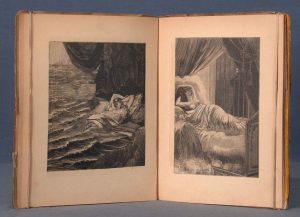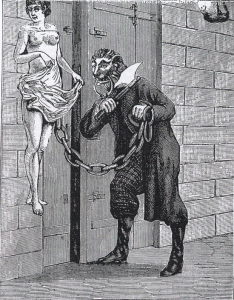To me, it seems that there is a significant link between collage and the manipulative way the media presents the news sometimes. I also remember one of the first articles we read for Mitchell, Ekphrasis and the Other, which emphasized the inseparability of some artworks from topics related to socio-political, gender-related and racial issues.
The first time I viewed Une Semaine de Bonte, I did not know it was a collage, nor did I know what a collage is, but I thought that Ernst’s style is certainly very strange in the way he juxtaposes different drawings or illustrations. After realizing that Une Semaine de Bonte is a collage, it made sense to me that the exaggerated interactions between the characters seemed strange (like the woman lying in a bed with a man gazing at her from behind the bars of a cage P. 49), it also made sense that the scene itself was not conceived in Ernst’s mind, perhaps only an idea of the argument he wanted to convey. I thought it was extremely unlikely for someone to blend these elements from different worlds into one scene.

I think the idea of collage evokes the purposeful way the media spreads the news to fix certain arguments. The media present pieces of news in a certain proportion, the crew chooses the images very selectively depending on the reaction they would like to evoke from the audience and they place different degrees of emphasis on the different pieces of news in order to direct viewers’ attention in a certain way. For example, last week there was a major controversy in Egypt about the transition of two islands, Tiran and Sanafir, in the Red Sea from Egyptian to Saudi Arabian property, some people protested against this decision, which the President took without referring to the Parliament’s opinion. However, the Daily News on the Egyptian national TV channel only hosted some politicians and strategist thinkers to analyse the president’s decision in flowery language that praised the benefits such a decision contributes to Egyptian political situation! There was no mention of the protests or of opposing views to the President’s decision. In this sense, the media seeks to link the news it presents to ideas of approval or rejection, optimism or pessimism.

I am truly intrigued by the ability of collage artists to juxtapose cultural and socio-political symbols in order to communicate their arguments effectively. Like the media, collage has the ability to make implicit links among many topics, which is why viewers need to be very careful in their assessment of collage works and the messages that they carry to society. Ernst does make a link to women as being used to men in power or very abusive of men’s sexual appeal to them. Till now, I am not sure if this is a critical argument or if he truly means to objectify women.




